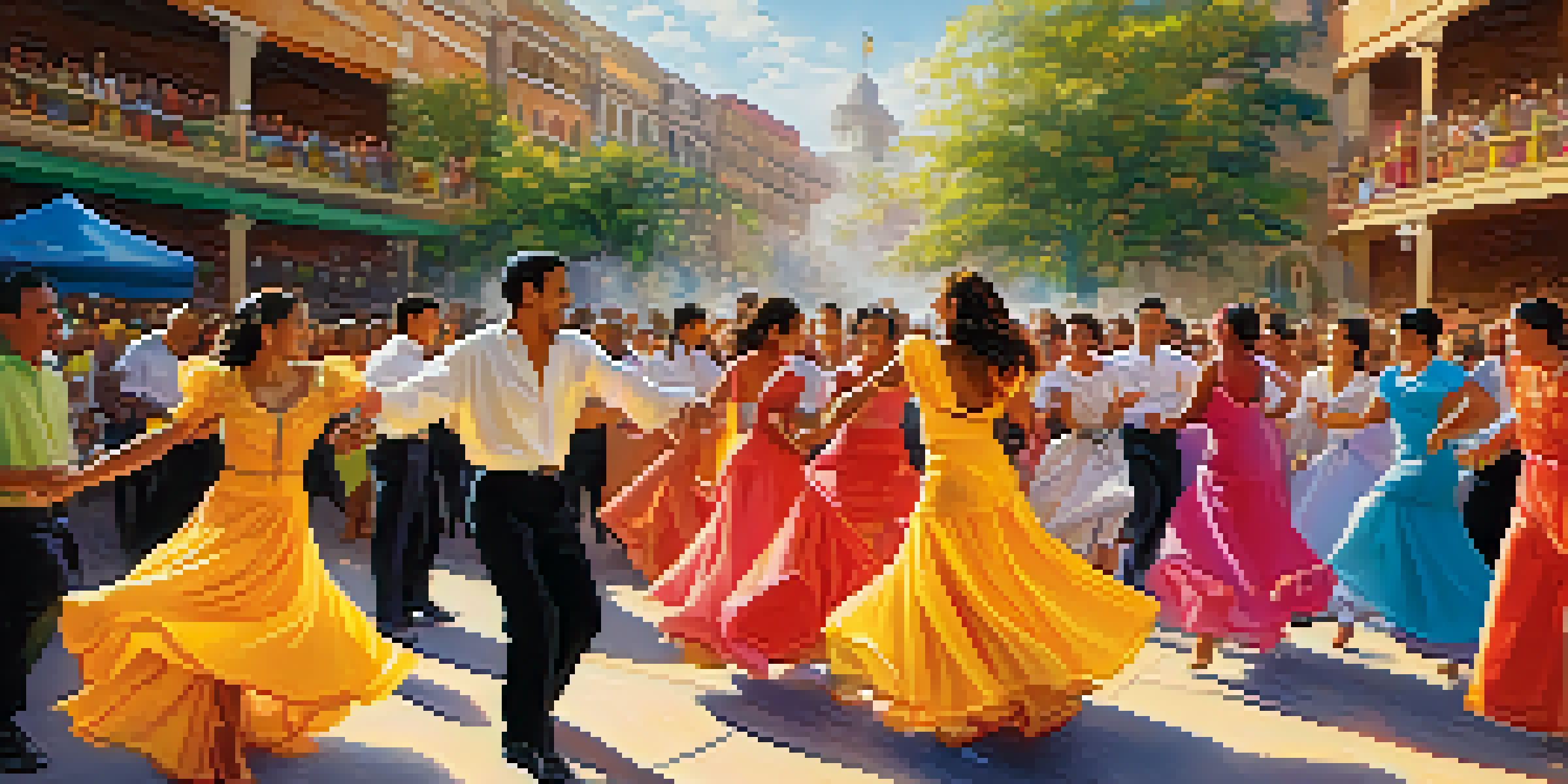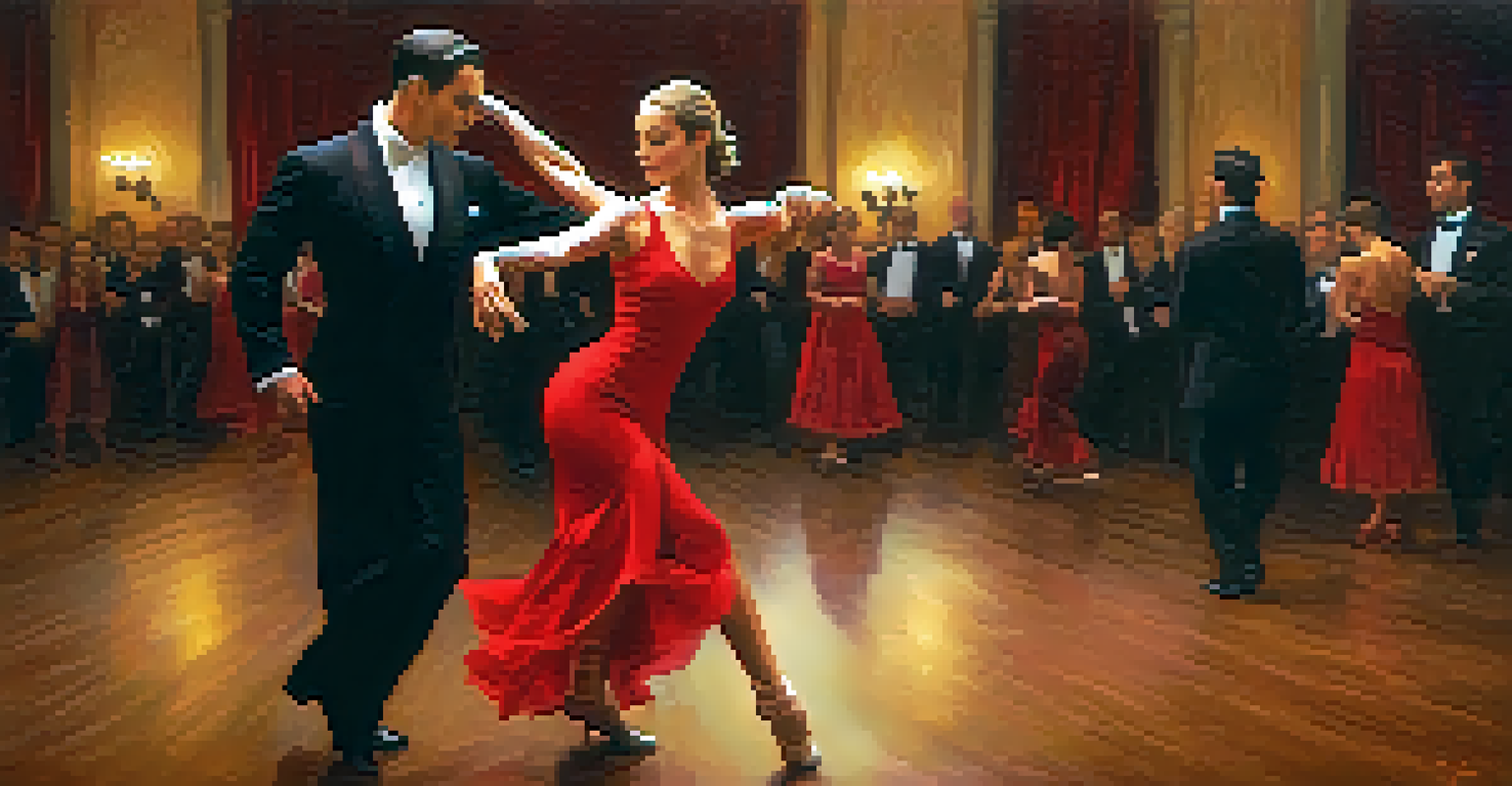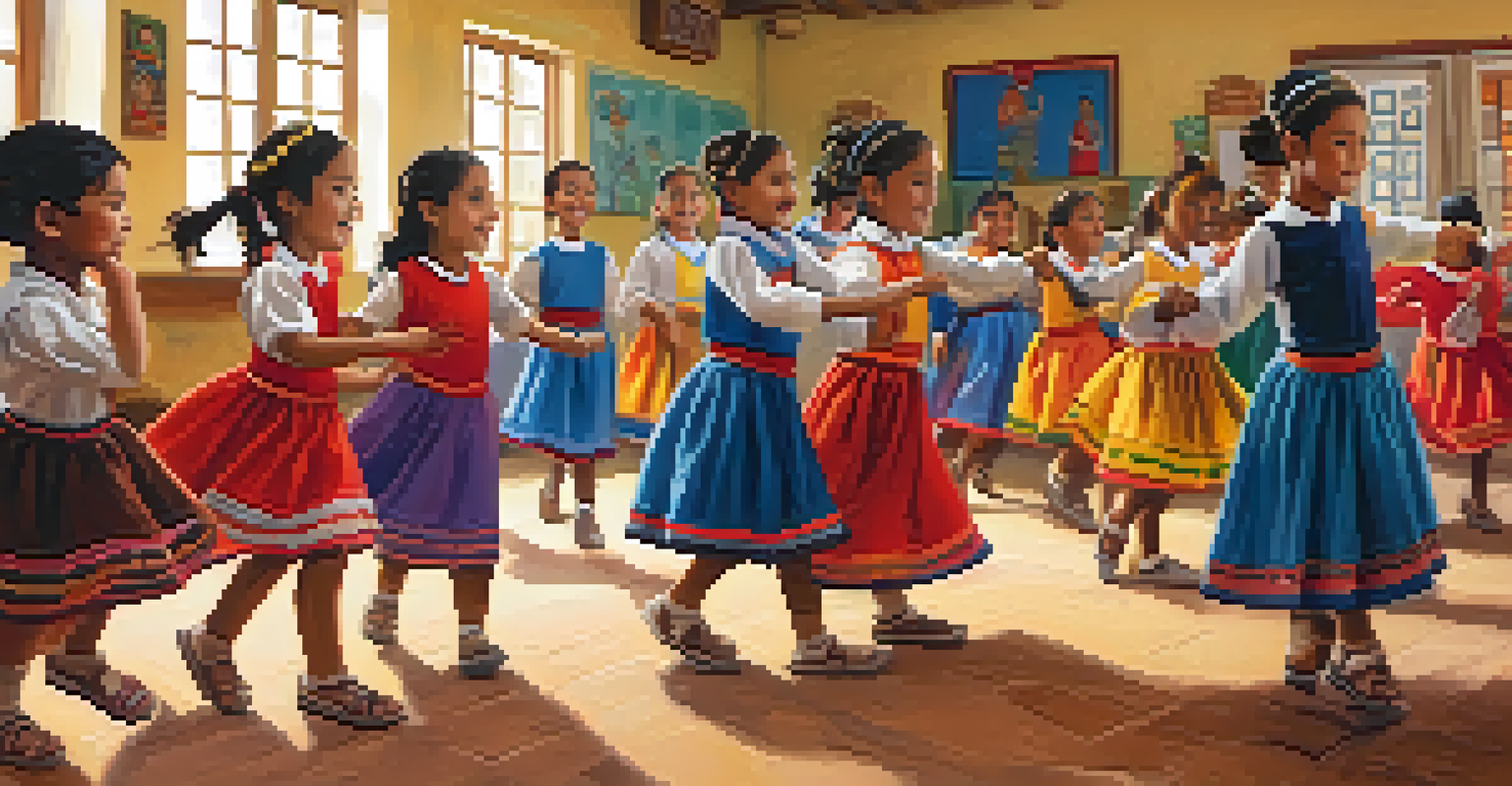The Role of Dance in Celebrating Latin American Heritage Today

Dance as a Cultural Expression in Latin America
Dance serves as a powerful medium for expressing the rich cultural tapestry of Latin America. Each dance style, from salsa to tango, tells a unique story that reflects the history and traditions of its people. Through rhythm and movement, dancers convey emotions, narratives, and values that resonate deeply within their communities.
Dance is the hidden language of the soul.
For instance, the vibrant salsa is not just a dance; it's a celebration of life and community, often performed at social gatherings and festivals. Tango, originating from the streets of Buenos Aires, embodies the passionate and sometimes tumultuous history of Argentina. These dances create a sense of belonging and identity that transcends generations.
Moreover, dance acts as a bridge, connecting the past with the present. It allows individuals to honor their ancestors while fostering a sense of pride in their heritage. In a world that often feels disconnected, dance brings people together, reminding them of their roots and shared experiences.
Dance Festivals: Celebrating Heritage and Community
Dance festivals are vibrant celebrations that showcase the diverse dance forms of Latin America. These events are not only about entertainment; they serve as a platform for cultural exchange and community bonding. Festivals like Carnaval in Brazil and the Fiestas de Quito in Ecuador attract thousands, highlighting the integral role of dance in these celebrations.

During these festivals, individuals of all ages come together to participate, watch, and learn, fostering a sense of unity and pride. Traditional costumes, lively music, and the spirit of joy contribute to an electrifying atmosphere where heritage is honored. This communal experience strengthens ties within communities and showcases the beauty of cultural diversity.
Dance Reflects Cultural Heritage
Latin American dance serves as a vibrant expression of cultural identity, telling stories and preserving traditions through rhythm and movement.
Additionally, dance festivals often include workshops and performances that educate attendees about the cultural significance of each dance style. This helps to preserve traditional dances and encourages younger generations to participate, ensuring that these cultural expressions continue to thrive in the future.
Dance in Education: Preserving Latin American Traditions
Incorporating dance into educational settings is essential for preserving Latin American heritage. Many schools and community programs are now offering dance classes that focus on traditional styles, allowing students to learn about their cultural roots in an engaging way. This hands-on approach not only teaches dance techniques but also instills a sense of pride and identity in young learners.
Dancing is creating a sculpture that is visible only for a moment.
For example, programs that teach folkloric dances often include lessons on the history and significance of the dances, creating a deeper understanding of their cultural context. Students not only dance but also appreciate the stories and traditions that have shaped their communities. This holistic approach to education fosters a stronger connection to their heritage.
Moreover, by participating in dance, students develop important life skills such as teamwork, discipline, and confidence. These classes become a space where cultural heritage is celebrated and reinforced, ensuring that the legacy of Latin American dance continues for future generations.
The Global Influence of Latin American Dance
Latin American dance has transcended borders, influencing dance scenes around the world. Styles like salsa, bachata, and reggaeton have gained immense popularity in various countries, showcasing the universal appeal of Latin rhythms. This global reach not only celebrates Latin culture but also encourages cross-cultural exchanges.
Dance studios across the globe are now offering classes in these vibrant styles, allowing people from diverse backgrounds to connect with Latin American culture. This fusion of cultures often results in innovative dance forms, illustrating how traditional practices can evolve while still honoring their origins. It’s a beautiful reminder of how art can unite people.
Festivals Foster Community Spirit
Dance festivals in Latin America create a lively atmosphere for cultural exchange, uniting people and celebrating their diverse heritage.
Furthermore, international dance competitions and events often feature Latin American styles, giving them a prestigious platform. This recognition helps to popularize these dance forms, drawing attention to their cultural significance and inspiring a new generation of dancers to explore and embrace them.
The Role of Dance in Social Movements
Dance has long been a tool for social change in Latin America, embodying resistance and resilience. From the protests in Chile to the performances in the streets of Colombia, dance serves as a form of expression that challenges social injustices. It unites individuals in solidarity, using movement to convey messages that words alone may not capture.
For instance, traditional dances are often performed during marches to celebrate cultural identity and advocate for rights. This powerful form of expression allows marginalized communities to voice their struggles while connecting with others who share their experiences. Dance becomes a symbol of hope and empowerment in the face of adversity.
In addition, contemporary dance artists are using their craft to address pressing social issues, blending traditional styles with modern narratives. This evolution of dance not only keeps traditional forms alive but also makes them relevant to current societal challenges, paving the way for dialogue and change.
Dance as a Tool for Mental and Physical Wellness
Engaging in dance offers numerous mental and physical health benefits, particularly for those celebrating Latin American heritage. The joy of dance can be a powerful antidote to stress, providing an outlet for self-expression and creativity. As individuals immerse themselves in the rhythm, they often find a sense of liberation that enhances their overall well-being.
Moreover, dance promotes physical fitness, improving coordination, strength, and flexibility. Latin American dance styles, with their energetic movements, encourage participants to stay active while having fun. This aspect is vital, especially in communities where access to fitness resources may be limited.
Dance Blends Tradition with Innovation
The future of Latin American dance lies in its ability to merge traditional styles with contemporary influences, ensuring its relevance and appeal.
Additionally, the social aspect of dance fosters connections and friendships, creating a support network that enhances mental health. Whether in a dance class or at a festival, individuals can build relationships that provide emotional support and a sense of belonging, reinforcing the idea that dance is not just an art form but also a vital part of community health.
The Future of Latin American Dance: Innovation and Tradition
As we look to the future, the evolution of Latin American dance continues to be a blend of innovation and tradition. New generations of dancers are experimenting with traditional styles, incorporating elements from other genres to create fresh interpretations. This fusion not only keeps the dance forms alive but also makes them accessible to a broader audience.
Dance companies and choreographers are now pushing boundaries, exploring themes relevant to contemporary society while honoring their cultural roots. This innovative spirit not only attracts new audiences but also invites dialogue about cultural identity and heritage in a modern context. It’s a dynamic interplay between preserving tradition and embracing change.

Ultimately, the future of Latin American dance lies in its ability to adapt while remaining true to its essence. By celebrating both the past and the present, dance will continue to thrive as a vital expression of Latin American heritage, ensuring that it resonates with future generations.